by Todd Rutherford
Who doesn’t love seeing the golden glow of aspen leaves (Populus tremuloides) dancing in the breeze on a mountain hillside? Many gardeners living at Colorado’s lower elevations have been smitten by the quaking leaves of aspen trees and tried to bring some of that mountain magic into their own yard. But doing so reveals lessons in plant ecology, and reminds us that not every plant we want to have in our home landscapes can easily grow there.
Aspens are a “succession” tree, moving into areas where other trees and shrubs were removed by logging, fire, erosion, insects or disease. As a succession species, they are not long lived. Their presence helps lead the way to other longer living trees.
In addition, aspens are highly susceptible to insect damages and diseases. Aspens that were collected in the wild are even more prone to damage and disease, as their root system is either injured or is incomplete during collection. Nursery grown aspens are generally healthier than collected ones, but still will likely succumb to problems and a shortened life.
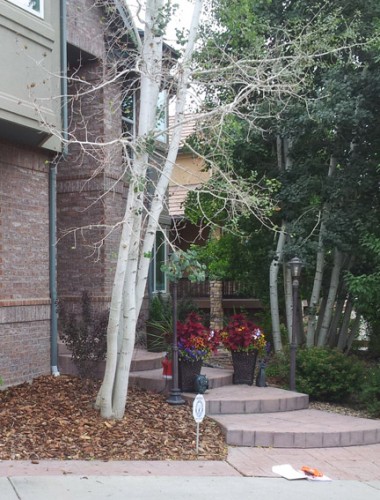
A diseased aspen tree.
Most arborists and horticulturists advise against planting Aspens along the Colorado’s Front Range. The growing conditions of the Front Range are different than those areas where Aspen thrive naturally. Aspens like to grow in gravelly, moist but well-drained soil with a lower pH (more acidic) that can typically be found at higher elevations. Along Colorado’s Front Range, our soils are typically heavy clay soils that don’t drain well and have a higher pH (more alkaline). Summer weather along the Front Range is hotter and drier than in the mountains, another factor going against the health of Aspens planted east of the high country.
If you really must have the quaking leaves of aspen in your yard, only plant them if you can place them in the north or east sides of your home (due to the afternoon heat of south and west exposures) and only if it is a nursery grown tree. Keep them away from objects that might radiate too much heat to the trees such as paving. Amend the soil with organic matter in an attempt to increase the acidity of the soil, and then mulch the newly planted tree well. You might also consider adding gravel or perlite to the soil before you plant to improve drainage, and reduce the problem of heavy clay soil.
Even if you can adhere to the aforementioned criteria while planting your aspen, it’s not likely your tree will achieve the brilliant gold of the aspens at higher elevations due to differences in soil chemistry, soil texture, soil moisture, day and night temperatures, and sunlight discrepancies at the different elevations. In addition you should be on the lookout for several different diseases and insects that more readily afflict aspens planted out of their native range.
Furthermore, if you want to remove aspen trees that are established in your yard, you may get many suckers (the stems that sprout up from aspen roots) coming up in your yard for many months after you removed the main trunk.
So in my opinion, no, aspen trees should not be planted in the Denver area, because it is not likely they will do well. But if you are aware of the many shortcomings of aspens planted outside of their native range, feel free to give them a try.
This is the official blog of Outdoor Design Group, Colorado Landscape Architects. For more information about our business and our services, click here.
Related Posts:
by Guest Writer
No matter what season it is, patios are an essential part of any outdoor setup. Design a great one for a sunny day with the kids, or for relaxing with friends by a fire pit. Here are 5 beautiful patios to draw inspiration from.
1. ALL INCLUSIVE IN BRICK
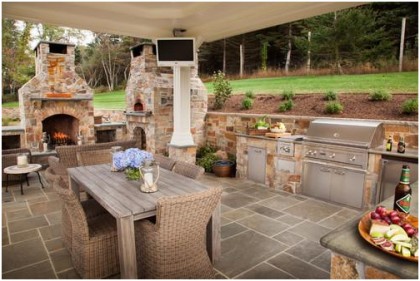
Via Houzz
Laid out in beautiful brick and stone work, this patio really has it all. It’s the perfect place for to hold that Labor Day barbecue or celebrate your favorite team’s latest victory. The layout of the grill, oven, and counter tops make this a streamline system for cooking food for the masses. Plus in the winter, you can cozy up in front of the fire to warm up between playing in the snow.
2. A LOVELY GARDEN
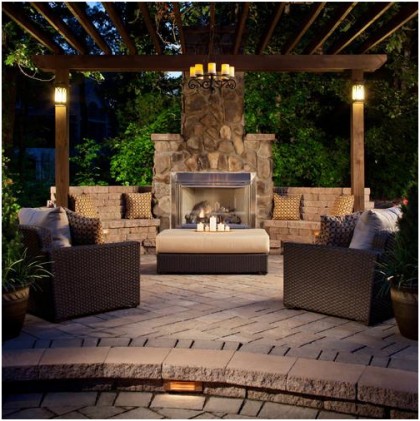
Via Houzz
Bring on the romance with beautiful trailing vines which give an open air effect while still providing shade and privacy. The fireplace becomes the central point with the seating curling around it, making it a cozy and intimate setting. Mix up the textures by bringing in some wicker furniture.
3. SUMMER DAYS
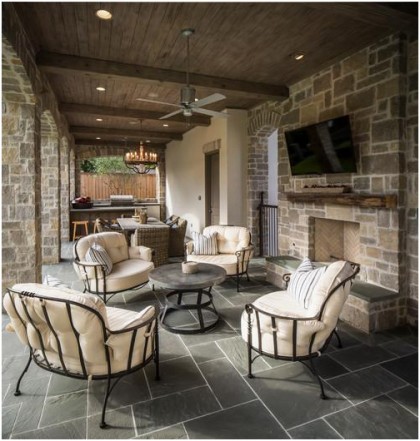
Via Houzz
For the dog days of summer, a ceiling fan comes in handy in this cool patio. It’s the perfect place to sip lemonade or as the bar off to the side implies, margaritas. With both a dining and a lounge side, this patio functions as a great outdoor dining room as well as a cool place to hang out in front of the TV in those ultra plush chairs. The stone next to the wood gives it a stylish contemporary look while keeping it classic.
4. SMOOTH AND SLEEK AND CONTEMPORARY

Via Houzz
With the smooth lines that make up the core of mid-century style, this patio is stunningly awesome. The wood panel housing for the grill is genius, not only does it provide a shield for your grill from the elements, but it also provides shade while you stand over it to slow cook your pork chops to perfection. Another really great touch is the lattice designs on the on the ceiling which adds a sense of artistry with the rest of the furnishings being solids.
5. PERFECT PARTY PATIO

Via Houzz
Think of this not only as a patio, but also as an extension to your kitchen. This is the perfect space to host a cookout. Serve up your favorite recipe from behind a bar with no concerns about people getting in the way. Enjoy some great lighting that bounces beautifully off the polished marble floor. There’s the plus of having a fireplace for people to gather around to roast marshmallows or TVs to catch the game, all while having the ability to cook without being shut away in the kitchen.
This is a guest post by Tim Smith of Modernize.com. For more inspiration on designs for your backyard, check out Modernize.com.
Related Posts:
by Todd Rutherford
As gardeners in Colorado may well know, our climate and altitude make for challenging growing conditions. This doesn’t mean we are completely immune from invasive exotic plants making an unwelcome home here. We do not have the burden that gardeners in wetter and warmer states may have at stopping the spread of invasive plants, but there are a few species you should be aware of so you can help stop these unwanted guests from gaining a foothold in our landscapes.
Why be concerned about invasive plants? They crowd out native plants, propagate uncontrollably, and may reduce forage for wildlife. Some may have a negative impact on your garden plants. And research suggests that some invasive species may pose dangers to humans through the increased risk of flooding due to damaged waterways, or increased fire danger.
The two worst invasive woody plants for Colorado and the surrounding region are the Russian Olive and the Tamarisk. Russian Olive (Elaeagnus angustifolia), is native to western and central Asia. It was introduced into North America in the latter part of the 1800’s. It is not related to true olive plants (Olea europaea) but its fruit is edible but not very palatable for human consumption. It out competes native plants because its seeds are irresistible to birds which spread the seeds far and wide. The seeds have a low mortality rate, germinate readily in poor soil (it can fix its own nitrogen in its roots), reach maturity quickly and thus outcompete native plants. In Colorado, they often begin setting a foothold in riparian areas, and then spread from there.
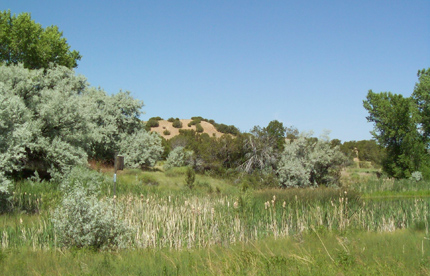
Russian Olives invading a wetland in New Mexico.
Tamarisk (Tamarix ramosissima), which is more of a shrub than a tree, similarly starts its spread in the riparian areas of the Colorado and other southwestern states. It has been such a successful invader of wet areas, that it has overtaken huge sections of the rivers of the southwest. However, it is not as tolerant of cold temperatures as is Russian Olive, which restricts its spread to the warmer, lower elevations of the southwest. Tamarisk is tolerant of many soil types, and thrives in full sun. One of the concerns about Tamarisk’s effect on native landscapes is how they out compete native vegetation, altering the nutrient cycles of riparian areas. They also consume large amounts of water, and secrete large amounts of salt, both items further slowing the success of nearby native plants. A massive amount of resources and manpower are being directed at the fight to stop the spread of this plant through the wildlands of the desert southwest.
…the Siberian Elm is “one of, if not the, world’s worst trees…a poor ornamental that does not deserve to be planted anywhere”.
Closer to Denver and the urban areas of Colorado’s front range, there are two trees that are common pests. These are the Siberian Elm (Ulmus pumila), and the Tree of Heaven (Ailanthus altissima). Both of these trees release a profuse amount of seeds, and these seeds are very adept at sprouting in disturbed areas. They proliferate along transportation corridors and abandoned lots. Both trees prefer full sun, but Ailanthus can tolerate some shade allowing it to invade some mature native forests.
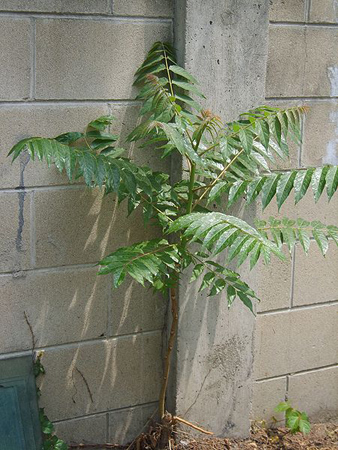
Young Ailanthus altissima
Although not directly related, Ailanthus trees (a.k.a. Tree of Heaven) are often mistaken as sumacs. In springtime they produce many flowers that have a foul odor which some say is similar to cat urine. It rapidly out competes other tree species, releasing an allelopathic chemical which inhibits the growth of other plants. Some researchers have extracted this chemical from Ailanthus trees, successfully using it as an herbicide. Not only is this tree toxic to other plants, there have been anecdotal reports of it being slightly toxic to humans and livestock. Ailanthus trees can grow quite rapidly, leading to weak, unstable branches.
Siberian Elms also have structural problems, with many weak or dead branches that can break off in heavy wind. Siberian elms have a short dormancy period which leads to early flowering in spring, and late leaf drop in fall. In Colorado that means they can become dangerously loaded with wet snow in our common heavy spring snowstorms, or the occasional fall snowstorm, leading to heavy branches falling on roofs and vehicles. In addition to the dangers of breaking limbs, the trees do not have a very favorable appearance, with an awkward branching pattern. One doesn’t need to search too long before you find many Siberian elm seedlings sprouting up in unwanted spots in the urban landscape. The sprouts show up in shrub beds where they are difficult to remove by hand and hard to spray with herbicides without damaging neighboring desired plant materials. Siberian elms are susceptible to damage from elm leaf beetles which leave the leaves looking skeletonized, but it doesn’t seem to kill the trees. Notable horticulturalist Michael Dirr says the Siberian Elm is “one of, if not the, world’s worst trees…a poor ornamental that does not deserve to be planted anywhere”.
To be fair, I should mention that some people look favorably upon these four tree species, and say that in Colorado’s high desert climate (that is naturally and predominantly tree-less east of the Rocky Mountains), an invasive tree is better than no tree, especially in urban areas. I would beg to differ, noting that these trees are too difficult to control and remove, to the detriment of native flora and fauna. Please become aware of these invasive trees and be considerate about whether you want to allow these in your landscape.
This is the official blog of Outdoor Design Group, Colorado Landscape Architects. For more information about our business and our services, click here.
Related Posts:
by Todd Rutherford
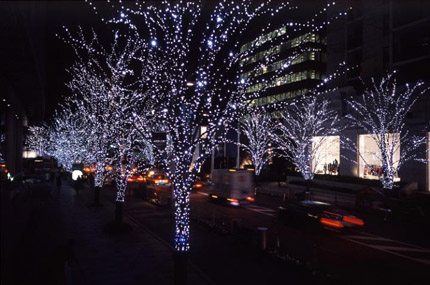
If you’ve not purchased holiday lights in several years, you are in for some surprises next time you head out shopping for new holiday lighting. Recent advances have produced a wave of new and innovative LED lighting that is far more energy efficient than holiday lighting your father or grandfather installed in years past. Many of the new LED holiday light strings are 7 to 8 times more efficient than traditional incandescent light strings. This translates to additional benefits aside from lowered electricity bills: more strings can be safely strung together end-to-end (which may mean a simplified layout of your light display) and there is a lowered fire hazard as the strings do not get as hot as many of the incandescent holiday light bulbs.
One down side to these new types of holiday lights is their higher up-front cost. But if you calculate in the lower operating costs, LED lights are likely to cost you less money in the long run. And as more LED holiday lights are being manufactured, prices have been dropping.
One criticism of LED lights has been the tendency of light from LED bulbs to appear harsh and “cold”. Manufacturers have responded to this issue and are now producing LED holiday lighting that appears “warmer”, like the incandescent lights they are intended to replace.
So this year, consider adding some ‘green’ lights to your holiday decor by choosing energy efficient LED holiday lights.
Here’s a list of pros and cons for LED Holiday lighting:
PROS
Lower energy use / operating cost
Lower heat output (Less fire hazard)
Longer life
More strings can be connected safely (Fewer outlets or extension cords needed)
CONS
Higher purchase cost than incandescent.
Color & “temperature” of light output difference as compared to incandescent
This is the official blog of Outdoor Design Group, Colorado Landscape Architects. For more information about our business and our services, click here.
Related Posts:
by Matt Corrion
Recently I had a client express frustration about his inability to kill the crabgrass weeds in his lawn.
It turns out that what he had was tall fescue rather than crabgrass. Tall fescue is a spreading cool season grass that often appears in lawns. It has a courser texture than bluegrass, and will sometimes “green up” in the spring earlier than the rest of the lawn.
How to Remove Tall Fescue
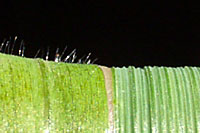
Crabgrass (left) has smooth leaves that often have small hairs. Fescue (right) has ridges on the leaves.
So here’s the thing about trying to remove it: Selective weed killers that target weeds such as crabgrass will not kill tall fescue.
The only way to remove the tall fescue is to treat it with a non-selective herbicide such as Roundup. This type of weed killer will also kill the lawn that is directly around it. Which means you will need to spot-seed that area, or if you have a lot of fescue you may need to remove the entire lawn and start over with seed or sod.
Should You Remove it at All?
In my lawn, I have clumps of tall fescue but I don’t like to use many chemicals on my lawn. I just leave the clumps in place- they are hardly noticeable once the lawn greens up.
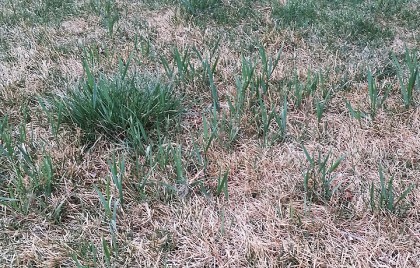
Tall fescue emerging in a bluegrass lawn that is still dormant in early spring.
Fescues are actually pretty highly recommended as lawn grasses- according to the Colorado State University Extension Office a fescue lawn can require up to 50% less water than a bluegrass lawn. In fact, one of the popular sod blends we often specify for the front range is a “90/10 Fescue Bluegrass” blend. That is, 90% fescue and 10% bluegrass.
So before deciding to use a bunch of chemicals on the fescue in your lawn, or doing a major lawn renovation – consider leaving it in place. The fescue can be hardly visible at all from a distance, and may end up saving you money in the long term on watering.
This is the official blog of Outdoor Design Group, Colorado Landscape Architects. For more information about our business and our services, click here.
Related Posts:










